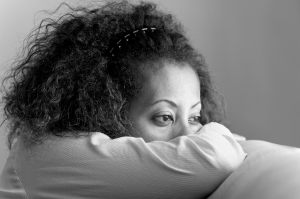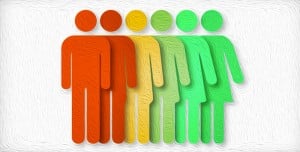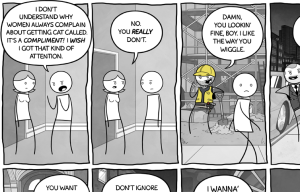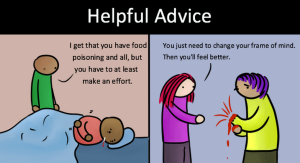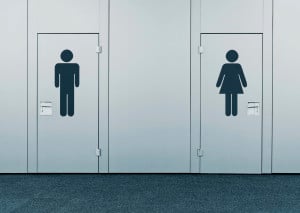We know that issues of class are issues of feminism.
We know the cultural myths that encourage us to blame the poor for their own poverty, and we know that poor folks suffer from a brunt of exhausting mind games in our money-obsessed society.
We know that our economy is structured in a way that limits the ability of poor people to get ahead. We know that, in turn, those poor folks suffer from workplace, education, and other forms of systemic discrimination.
Because we know that these societal mechanisms exist, feminists have long worked to change them, and that fight has always been personal.
Across lines of age, race, and sexuality, women are the poorest in their communities.
And it’s because the way our culture treats issues of class, gender, violence, and family devalues women’s labor and denies them the opportunities they need to compete alongside men on equal footing in the workplace.
The “feminization of poverty” describes the social and economic patterns that keep women disproportionately poor around the world.
Although the term specifically addresses only the whole of “women,” it’s also worth adding that women living at the intersections of oppression – like women of color, trans women, and less-educated women – feel the impact of gendered class oppression the most.
In America and across the globe, women bear the brunt of financial insecurity and find themselves struggling to maintain or amass wealth like their male counterparts.
When women are poor, it negatively impacts families, children, and entire economies.
And yet, at home and abroad, the feminization of poverty persists.
There are policies in place in America that are meant to keep women afloat and give them a fair shot at financial stability and even economic opportunity, but for decades they’ve fallen short of actually ending workplace discrimination and other factors that hold women back.
Instead, women’s wages have gone stagnant, and women continue to find themselves on the bottom of every ladder, looking up through a glass ceiling.
Whether it’s the impacts of the wage gap, violence, or an imbalanced workforce that keep women poor, there are things everyone – even you and I – can do to end the gendered impacts of poverty – and, along with them, many of the class issues that keep all poor and working-class people down.
Money and poverty are a numbers game. That’s why there’s no better proof of inequality than statistics when it comes to issues of class, and especially the feminization of poverty.
The following five statistics prove that women are suffering most here at home from class oppression – and for each, there’s at least one action we can all take to change them.
1. 18 Million Women Live in Poverty in the US Alone
Despite the overall poverty rate declining in America, 18 million women remain below the poverty line.
That’s one in seven American women – and 40% of women who head up families.
Women are poorer than men in every state, regardless of education or geographic location. And for women of color, elderly women, and LGBTQIA+ women, it’s even worse.
The poverty rate for Native American, Black, and Latina women is almost double the poverty rate for white women. 27.6% of Native American women and 26.6% of Black women live in poverty.
5.1 million LGBTQIA+ women are on the brink of poverty, and only 24% of LGBTQIA+ women would say they are “financially thriving.”
For LGBTQIA+ workers of color, and especially women and gender-nonconforming queer workers of color, a lack of workplace protections and career-oriented resources and opportunities leaves many in the community unemployed, financially insecure, and all-around flat broke.
The rate of elderly women in poverty skyrocketed up 18% in 2012, and retired women are twice as likely to live in poverty than their male counterparts.
To lift women out of poverty, policymakers and advocates have to address the specific gendered impacts of poverty as well as its gendered roots.
That means carving out spaces for women specifically to learn about financial management, entrepreneurship, and investing in our communities. That means seeing anti-poverty programs and other economic programs like SNAP, Social Security, and Welfare as integral to equalizing women’s opportunities.
That means making salary negotiations that have nothing to do with gender and employment processes more focused around diversity. And it means working on economic issues with a gender lens that examines differences along the lines of race, age, sexuality, gender identity and presentation, and ability.
2. Domestic Violence Survivors Lose 8 Million Days of Paid Work Per Year
Women are the majority of victims of intimate partner violence and domestic violence – and the abuse they suffer keeps them struggling financially.
Nearly 8 billion days of paid work per year are lost due to domestic violence, and 96% of victims experience problems at work related to their abuse.
A majority of Americans have observed and believe that the Great Recession and a long-standing economic downturn has made things worse for domestic violence victims – victims who may stay in a relationship with an abusive partner for economic reasons or face worse abuse due to economic stressors.
Moreover, the impact of financial abuse – when abusers interfere with gainful employment opportunities, control financial resources, or negatively impact the credit of their victims – can leave survivors lagging behind other women when they do leave a relationship with an abusive partner.
Despite a clear need for these kinds of resources, domestic violence shelters and other social programs that assist survivors in recovery and re-establishing careers are struggling to survive across the country.
These kinds of programs are invaluable for women looking to create stable, violence-free lives, and they keep abuse victims safe and off the streets.
We need to keep these shelters open, and we need to ensure that they are as inclusive and all-encompassing as possible.
3. 12,728,000 Women Work in Low-Paying Fields
Women are often pushed into “pink collar jobs” – like teaching, nursing, and service jobs – that pay less, in part due to gender discrimination that lets us consider “women’s work” less valuable than work fields dominated by men.
In 2007, 43% of women in the workforce were employed in just 20 disciplines, all with a median income of just $27,383 per year.
In the same year, less than 15% of women were employed in management, financial operations, or business jobs. For women of color, segregation into low-paying jobs is even more common, and leadership even more rare.
Moreover, women make up a majority of low-wage service-sector jobs, such as fast food front-line work, and retail positions.
For women, and especially women of color, the fight to raise the minimum wage to $10.10 or $15 is very personal – and could be the difference, for them, between barely surviving and finally thriving.
28 million workers would benefit from a raise if the Minimum Wage Fairness Act passed through Congress, and a majority of them would be women.
Joining the Fight for 15 or pushing for local, state, or national minimum wage increases – as well as protections for low-wage workers, who are often exploited – would keep millions of families above the poverty line.
Supporting and helping to sustain programs that prepare women for work in male-dominated fields will also help women, over time, close the achievement gaps in their chosen industries.
Whether that means speaking up for women in tech or volunteering at trainings for women who run their own businesses, giving women the space to learn new skills and the support network to practice them is key in helping them access more leadership positions and job opportunities across the board.
4. Women Make at Least 23% Less Than White Men at Work
The Equal Pay Act, which banned gender-based wage discrimination, was signed into law in 1963 – over 50 years ago.
Although we’ve seen slight progress since then on closing the wage gap for women, discrimination persists – and its impact haunts women for the rest of their working and retired lives.
Overall, women earn, on average, 78 cents to every white man’s dollar in America. That means that over a lifetime, women lose an average of $434,000 to the wage gap.
This kind of inequality is seen across fields and seniority, and is actually worse for women of color, LBTQIA+ women, and women with more academic achievements.
Black women make 64 cents on that white man’s dollar, and Latina women make only 54. This means that although all women are suffering economically from the wage gap, women of color carry an even heavier burden.
A recent study also found that even in states with the smallest wage gaps, women of color experienced some of the largest gaps in the nation.
On top of the wage gap, LBTQIA+ women suffer from penalties for their gender identities and sexualities in the workplace.
And the reason so many elderly women live in poverty is because the impact of workplace discrimination like the wage gap leaves them with less overall earnings, a smaller pot of money in their savings, and less financial security throughout their lifetimes.
Closing the wage gap would cut poverty for working women in half. But attempts to do so have been met with a lot of political and social backlash, including claims that the scientifically proven wage gap doesn’t exist. (Pro tip: It does.)
The Paycheck Fairness Act, which has failed to pass through the House twice, would eliminate barriers to equal pay for women in the workforce. It would make it safe for workers to discuss their salaries without fear of retaliation, which is a luxury many workers aren’t afforded. It would also extend the amount of time women have to press charges for wage discrimination once it begins.
These kinds of reforms would help women workers demand equal pay, and make it possible for them to do so without risking their careers.
5. 43% of Women Leave the Workforce After They Have Kids
Whether it’s poor maternal leave policies, an inability to structure their jobs and access flexible work environments, or the caretaking duties – which so often fall on their shoulders – the careers of women with children are suffering simply because of their gender.
Some of those women leave because caring for a family becomes too imposing to allow them to keep up at work.
They’re more likely than men to experience career interruption after starting a family, and research has proven that those interruptions become obstacles to future employment and success for working moms.
When parents don’t live together, women are more likely than men to shoulder childcare costs, and even in partnered households they do a brunt of the unpaid and often unappreciated domestic labor.
But even when everything is good at home, pregnant women and mothers still suffer at work.
For some pregnant workers, asking for accommodations at work or even doing as their told by a doctor during the workday can leave them without a paycheck or a job.
The Pregnancy Discrimination Act was put in place 37 years ago to end this kind of gender-based discrimination against expecting employees, but complaints about pregnancy discrimination have actually been on the rise.
One even went before the Supreme Court this year.
And after they’ve had children, women can expect to pay the “Motherhood Penalty” at work.
They miss out or be passed over for advancement opportunities, see an overall stagnation or decrease in earnings, and potentially go up against inflexible environments that make it impossible for them to balance their career and their families.
Men who parent, however, are rewarded for doing so with higher earnings and more opportunities for advancement.
The Pregnant Workers Fairness Act would close loopholes in the PDA and help pregnant women remain at work without putting themselves in harm’s way – but Congress is stalled on passing it.
Fighting for national reforms like the PWFA, as well as supporting efforts to make childcare affordable and workplaces more flexible, will help working moms juggle their responsibilities without having to sacrifice some of the most fulfilling aspects of their lives.
One of the most important aspects of intersectional feminism is the understanding that when we fight for the most marginalized women, we liberate all women along with them.
While it’s possible that none of these statistics encompassed or addressed your experiences – but for millions of women, this data represents a lived experience that is wrought with financial insecurity and societal challenges. When we act to improve the lives of those women, we all stand to benefit.
Money and poverty are a numbers game. But we have the power to change the math.
[do_widget id=’text-101′]
Carmen Rios is a Contributing Writer for Everyday Feminism. She splits her time disparately between feminist rabble-rousing, writing, public speaking, and flower-picking. A professional feminist by day and overemotional writer by night, Carmen is currently Communications Coordinator at the Feminist Majority Foundation and the Feminism and Community Editor at Autostraddle. You can follow her on Twitter @carmenriosss and Tumblr to learn more about her feelings.
Search our 3000+ articles!
Read our articles about:
Our online racial justice training
Used by hundreds of universities, non-profits, and businesses.
Click to learn more
Most Read Articles
- « Previous
- 1
- …
- 30
- 31
- 32


